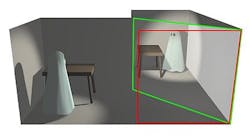
Almost half a century has passed since Emmett Leith and Juris Upatnieks showed that off-axis laser holography could produce stunning three-dimensional images that looked like objects floating in space. Their success made newspaper headlines, and enchanted optics researchers who soon duplicated the feat. Science fiction set future scenes with holovision replacing television, and holographer Gene Dolgoff inspired Gene Roddenberry to add a Holodeck to Star Trek. Today the general public's view of holography has more to do with science fiction than reality, and a new wave of marketing hype is further muddying the picture.
Leith and Upatnieks' first 3D holograms of a toy train launched a wave of holographic excitement in the 1960s and 1970s. I encountered my first laser as a Caltech undergraduate working one summer in a holography lab. That early wave of holography yielded iconic holograms, such as a life-size hologram of Dennis Gabor at his desk, and "The Kiss," Lloyd Cross's multiplex hologram showing a woman blowing a kiss. Recently, low-resolution holographic telepresence in near-real-time had been demonstrated with photorefractive materials and digital technology. But generally, the public's idea of iconic holograms are the image of Princess Leia in the 1977 Star Wars film, the Star Trek Holodeck, and ghostly "holographic" images of long-dead rapper Tupac Shakur performing on stage with living artists. All are special-effect tricks, none were holographic, and none even used the stereoscopic effect of 3D movies.
It's only getting worse. On July 11, 2013, a company called Provision Interactive Technologies (Chatsworth, CA) launched a Kickstarter project seeking $950,000 to develop "life-size 3D Holographic displays." As Matt Brennesholtz points out in Display Daily, the display is neither 3D nor holographic. It's a new twist on the old "Pepper's Ghost" illusion which projects a 2D image onto an angled screen so it appears to float in the air in front of the viewer. That's the trick used in the Tupac "holograms" and in the "holographic telepresence" talks given by futurist Ray Kurzweil and others. From all accounts, it works very well. But it's neither 3D nor holographic.Provision Interactive has been using the effect in smaller kiosk displays, and sought Kickstarter funding to pay for the expensive two-meter-sized optics their patented design needs to project a life-sized image of a person up to 2 m in front of the display. If you want details, you can check their patent, issued in October 2012. As of this writing on August 5, Kickstarter has suspended the Provision Interactive project because of an "intellectual property dispute." I wish someone would put as much effort into assuring that any display called "holographic" actually uses holograms.

Jeff Hecht | Contributing Editor
Jeff Hecht is a regular contributing editor to Laser Focus World and has been covering the laser industry for 35 years. A prolific book author, Jeff's published works include “Understanding Fiber Optics,” “Understanding Lasers,” “The Laser Guidebook,” and “Beam Weapons: The Next Arms Race.” He also has written books on the histories of lasers and fiber optics, including “City of Light: The Story of Fiber Optics,” and “Beam: The Race to Make the Laser.” Find out more at jeffhecht.com.
